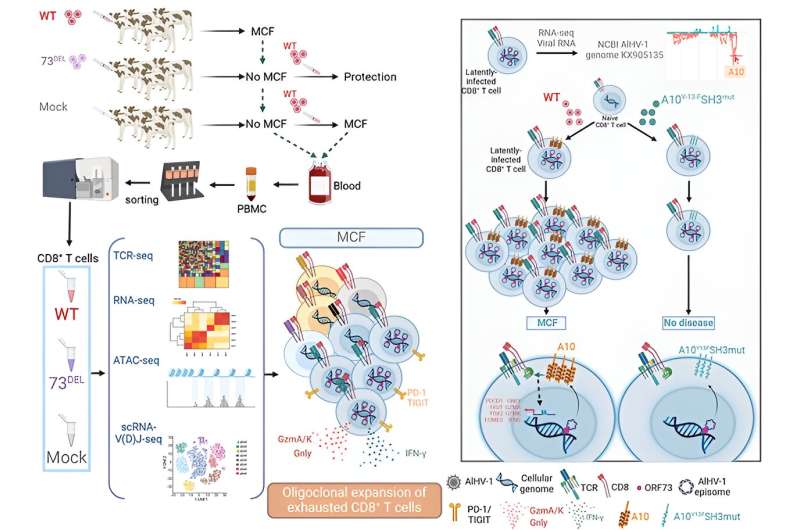This article has been reviewed according to Science X's editorial process and policies. Editors have highlighted the following attributes while ensuring the content's credibility:
fact-checked
peer-reviewed publication
trusted source
proofread
Study offers hope for development of vaccine capable of protecting cattle against malignant catarrhal fever

A research team led by University of Liège scientists has published a groundbreaking study on malignant catarrhal fever (MCF). This disease is caused by the alcelaphine gammaherpesvirus 1 (AlHV-1), which infects its natural host, the wildebeest.
The study sheds light on the mechanisms by which this virus, which is asymptomatic and latent in the wildebeest, causes an oligoclonal expansion of CD8+ T lymphocytes in cattle, leading to the development of MCF.
In 2013, the research team demonstrated that malignant catarrhal fever (MCF), which is fatal in cattle, only develops if the AlHV-1 virus can maintain a latent state replicating its viral genome in CD8+ T lymphocytes without producing viral particles.
"In this new study, we used high-throughput sequencing approaches on CD8+ T lymphocytes from sick cattle, compared with healthy animals," explains Benjamin Dewals, a researcher and lecturer at the University of Liège. "We were able to characterize the T lymphocyte repertoire (TCR sequencing) as well as the expression of cellular and viral genes specifically regulated during infection."
The study is published in Proceedings of the National Academy of Sciences.
Discovery of a crucial viral gene
Thanks to these analyses, the team identified a viral gene coding for a protein, called A10, potentially involved in the intracellular signaling of infected cells. "This protein turned out to be essential for the development of the disease without affecting viral replication in cell culture," explains Meijiao Gong, Ph.D. student at ULiège and first author of the article. "In addition, we have shown that phosphorylation of A10 alters the phenotype of T lymphocytes, causing their proliferation and the development of MCF."
The results obtained provide an in-depth description of the reprogramming of CD8+ T cells during infection with AlHV-1 and identify A10 as a key element in the development of MCF.
The discovery opens up new perspectives for understanding the mechanisms of malignant lymphoproliferation induced by herpesviruses and provides a promising basis for the development of an effective vaccine against this bovine disease.
"This study represents a significant step forward in our understanding of malignant catarrhal fever and offers hope for the development of a vaccine capable of protecting cattle against this devastating disease," concludes Benjamin Dewals.
More information: Dewals, Benjamin G., Unraveling clonal CD8 T cell expansion and identification of essential factors in γ-herpesvirus-induced lymphomagenesis, Proceedings of the National Academy of Sciences (2024). DOI: 10.1073/pnas.2404536121
Journal information: Proceedings of the National Academy of Sciences
Provided by University de Liege





















